Workplace: How to integrate crisis exit measures in a long-term strategic vision?
Sponsored Article by Ergonoma
BICG, the Business Innovation Group, editorial service, a study on the consequences of the health crisis, June 2020
The changes have accelerated. What was perceived as the complex was suddenly generalized, such as remote work, and on the whole allowed business continuity? However, the transitional measures often seem to contradict the long-term working environment strategies envisaged before, leaving us with a feeling of uncertainty about investments in terms of working environments. So how can we capitalize on these upheavals by integrating them into a long-term strategic vision? We can indeed take advantage of this moment of volatility, uncertainty, complexity, readjustments, to develop ourselves in a more agile, more ambitious, more flexible, and more in line with our aspirations way. The barriers are rising, and to embrace the opportunities that arise, or to avoid sinking, it is essential to think in an integrated way of the developments that we want to endorse or initiate.
6 questions necessary to know how to capitalize on the changes made
1/ What processes or activities can be carried out in a distributed manner – and with what efficiency and effectiveness – and which ones cannot? How to align them with the organization’s business continuity strategy?
2/ What levels of innovation, productivity, agility, and quality can we achieve for the different tasks to be accomplished according to where, how, when, with whom, and with what tools they are performed?
3/ After this period, how do we want and can we use our space infrastructure and what are the optimization levers we have?
4/ After moving from a world of face-to-face work to an extremely distributed world, what have we learned? What does this imply in the future in terms of collaboration, management, use of spaces…?
5/ How can the experience of employees and customers evolve in this new reality? What are the opportunities, the risks, and the various possibilities that arise?
6/ Which organizations are benefiting from this profound transformation and how are they doing it?
Designing a new model of work forms
These questions, therefore, relate to a broad spectrum that influences the definition of models of mobility, flexibility, and workspace ecosystems. What will the office of tomorrow be used for if the activities can be carried out in a distributed manner? All of our studies show that it is collaboration, exchange, experimentation and the need to form a group that will represent the main motivations for going to a commonplace of work
• New dynamics and working methods
• Redefining and simplifying processes
• Evolution of culture, leadership and personnel management
• Creation of new professional profiles
• Training and education, adoption of agile working methodologies
• Social, human, economic and environmental responsibility
• Employee well-being, consistency between vision and actions
• New technologies, knowledge transmission and collaboration tools
• New uses of office space and mobility policies
• Potential medium and long term impacts on the property portfolio
• New potential points of contact with customers

Each of these issues must finally be accompanied by the implementation of key performance indicators (KPI) and operational performance (OKR) monitored from a dashboard centralizing information in order to measure the impact of new measures and initiatives on the working model and to develop corrective or progressive measures of the changes made.
6 questions necessary to know how to capitalize on the changes
1/ How to integrate sustainability (human, economic, and environmental) as well as CSR and the well-being of our professionals in our culture and our practices?
2/ What will the new corporate culture, the new leadership model look like, and what new work rituals and rules should we establish in the new normalcy?
3/ What technological and organizational infrastructure will we need to radically increase flexibility, adapt to new models of interaction in the way we work, and respond to the necessary security measures?
4/ What will be the impact of these new working methods on our productivity, agility, quality, or innovation and how shall we measure it?
5/ What is the point of maintaining our sites and what shall we need in the future to generate employee engagement?
6/ Where is it possible to limit costs and what are the opportunities to seize vis-à-vis our customers? How will relationships with stakeholders evolve?
The parameters which are taken into account and which are correlated with the work environment go far beyond space: mobility, third places, remote working (anywhere anytime) are for example factors that are increasingly taken into account in the design of internal procedures which must accompany new forms of work.

• Culture and talent
The culture is evolving towards greater flexibility, and the ability to adapt the organization in parallel with an increase in demand from employees for alternative and distributed working methods.
• Technology and tools
Digitalization becomes the fundamental engine to articulate new relationships and opportunities, whether with customers, suppliers, society, or between employees. The automation of certain tasks is this way to put in parallel new skills and professions which will be necessary and for which the collaborators can co-define the contours and the necessary training.
• Offices, services, properties
The use of the office and the real estate portfolio is questioned: if the optimizations carried out within the framework of the deployment of internal mobility policies (flex-office for example), teleworking as it was experienced by the employees caused a desire to work differently: the office of tomorrow, therefore, seems more collaborative and experiential than ever.
• Process Organization
The processes have often been simplified to allow activities to operate with a certain continuity despite the relocation of work teams. Going back often seems counterproductive and could cause reluctance: on the other hand, continuing this simplification of internal procedures will allow organizations to be more agile and efficient while retaining their talents.
• Relations with stakeholders (suppliers, NGOs, public authorities, etc.)
The organization’s stakeholders also experience their own changes which must be taken into account and supported: they can represent opportunities, and maintaining stable relationships with external actors is a major stake in the social responsibility of organizations.
• Client experience
Digital uses have intensified; business and service models have evolved rapidly, have intensified, and consumers and businesses alike are becoming more familiar with these new channels and tools; it is, therefore, essential to accelerate the digitalization of relevant services and to take into account changes in consumers’ perceptions.
• New opportunities
New opportunities present themselves for companies, which redirect their offers by integrating more digital solutions and by considering audiences through the experience that we want to transmit to them and by which we will be recognized.
One of the major consequences of the health crisis is the massive and extremely sudden, if not precipitated, adoption of remote working. Psychosocial risks are significant and management models have started to evolve to avoid overwork and stress. Carried out against the clock, these developments are intensifying and, in many cases of success, are heading towards better managerial practices, such as management by negotiated objectives. Similarly, this remote work raises the question of the reasons for going to a common workspace, while pointing out the
risks linked to disengagement of employees vis-à-vis the organization. Finally, a direct effect consists of wondering whether a reduction in the volume of workspaces would not be justified in this new context.
According to studies carried out by BICG with organizations from all sectors in more than 20 countries, the reasons for coming to the office are always less linked to face-to-face control, access to information or concentrated work, but rather converge towards formal or informal collaboration, internal or external, and the generation of links between employees and with the company. The incorporation of tools and typologies of spaces allowing an enriching collaborative work, favoring human exchanges, experimentation, or even generating new ideas, appears
as the main success, factor to bring collaborators to find themselves in a common space.
The office, therefore, becomes a community generator, space where people meet, come together to experiment, generate links, work as a team, and acquire a sense of belonging and unity. The overall increase in remote work and the reconsideration of the office as a meeting and exchange space, however, makes it possible to envisage a reduction in the real estate portfolio in the years to come: a minimum optimization of 30% of the total workspaces, for large companies, would be possible. But the adoption and development of third places, closer to homes or the
activities of employees, customers, and partners, could partially offset this decrease in tertiary areas.

Integrated approach and gradual implementation
The most powerful lever of transformation, but which also represents the greatest challenge is the culture of the organization, the perceptions, and the adhesion of the collaborators. If the definition of a new working model is not based on a qualitative, deep, and participative consultation of employees, of all types of crafts, it cannot materialize by a real and functional transformation. The various initiatives launched subsequently must include a share of potential coconstruction with the members of the organization, allowing their understanding and assimilation. Internalization and adhesion will be all the more powerful since the collaborators will have decided, within a defined framework, of these evolutions. Finally, they must be reinforced by a continuous process of support for change, backed by a circular, constant, and transparent internal communication.
5 questions for a progressive and integrated approach
1/ How can we coordinate the different initiatives to really improve the way we work?
2/ What will be the working methods in the new normalcy?
3/ What units and disciplines need to work in coordination to ensure the overall success of the initiatives?
4/ What will be the impact of this new normalcy in terms of sustainability, whether human, economic, or environmental?
5/ How should we manage the relationship with the different stakeholders involved in progressive implementation, from customers to stockholders, including suppliers, workers’ representatives, and public administrations?
Before entering a new reality, we go through an intermediate phase during which different exogenous factors condition our daily activities. Returning to work becomes a real challenge when you consider the restrictions and regulations that must be applied, as well as the very differentiated and diverse situations that accompany it. The main challenge, therefore, is to keep professionals at the center of all concerns, in order to preserve their health first, while guaranteeing business continuity.
By considering workspaces as places of socialization which embody the company in the space and promote relationships between its members, by developing management models, internal communication and the working tools of employees, it is possible to deploy models of agile working environments based on collaboration which was in many cases previously considered and will
make it possible to respond to any other potential crisis. Constructive engagement of employees in the development of these new forms of work is essential to ensure the
sustainability of today’s investments as well as the ability of organizations to adapt and preserve the continuity of their activities in the face of the uncertainties that seem to be
strewn in coming years.

